Term 2 Unit 2 | History | 6th Social Science - Exercises Questions with Answers | 6th Social Science : History : Term 2 Unit 2 : Great Thinkers and New Faiths
Chapter: 6th Social Science : History : Term 2 Unit 2 : Great Thinkers and New Faiths
Exercises Questions with Answers
EXERCISES
I. Choose the
correct answer:
1. What is the name of the
Buddhist scripture?
a)
Angas
b)
Tripitakas
c)
Tirukkural
d)
Naladiyar
Answer: b) Tripitakas
2. Who was the first Tirthankara
of Jainism?
a)
Rishabha
b)
Parsava
c) Vardhamana
d)
Buddha
Answer: a) Rishabha
3. How many Tirthankaras were
there in Jainism?
a)
23
b)
24
c)
25
d)
26
Answer: b) 24
4. Where was the third Buddhist
Council convened?
a)
Rajagriha
b)
Vaishali
c)
Pataliputra
d)
Kashmir
Answer: c) Pataliputra
5. Where did Buddha deliver his
first sermon?
a)
Lumbini
b)
Saranath
c)
Taxila
d)
Bodh Gaya
Answer: b) Saranath
II Match the
Statement with the Reason. Tick the appropriate answer:
1.
Statement: A common man could not
understand upanishads.
Reason: Upanishads
were highly philosophical.
a. Statement and its Reason are correct.
b.
Statement is wrong.
c.
Statement is true, but the Reason for that is wrong.
d.
Both Statement and Reason are wrong.
Answer:
2.
Statement: The Jatakas are popular
tales.
Reason: Frescoes
on the ceilings and walls of Ajanta caves depict the Jataka Tales.
a.
Statement and its Reason are correct.
b.
Statement is wrong.
c.
Statement is true, but the Reason for that is wrong.
d.
Both statement and Reason are wrong.
Answer:
3. Find out the correct answer:
Buddha Viharas are used for
1.
Education
2.
stay of Buddhist monks
3.
Pilgrims’ stay
4.
Prayer hall
a.
2 is correct
b.
1 and 3 are correct
c.
1, 2, 4 are correct
d.
1 and 4 are correct
Answer:
4. Consider
the following statements regarding the causes of the origin of Jainism and
Buddhism.
I.
Sacrificial ceremonies were expensive.
II.
Supertitious beliefs and practices confused the common man.
Which of the above statement (s) is/are
correct?
a.
Only I
b.
Only II
c.
Both I & II
d.
Neither I nor II
Answer:
5. Which
of the following about Jainism is correct?
a.
Jainism denies God as the creator of universe.
b.
Jainism accepts God as the creator of universe.
c.
The basic philosophy of Jainism is idol worship.
d.
Jains accept the belief in Last Judgement.
Answer:
6. Circle the odd one:
Parsava,
Mahavira, Buddha, Rishaba
Answer:
7. Find
out the wrong pair:
a.
Ahimsa - not to injure
b.
Satya - to speak truth
c.
Asteya - not to steal
d.
Brahmacharya - married status
Answer:
8. All the following statements
are true of Siddhartha Gautama except:
a.
He is the founder of Hinduism.
b.
He was born in Nepal.
c. He attained Nirvana.
d.
He was known as Sakyamuni.
Answer:
III Fill in the
blanks:
1. The
doctrine of Mahavira is called Tri-rathnas.
2. Nirvana is a state of freedom from suffering and rebirth.
3. Gautama Buddha was the founder of Buddhism.
4.
Thiruparthikundram, a village in Kanchipuram was once called Jina Kanchi.
5. Stupas were built over the remains of Buddha’s body.
IV True or False:
1.
Buddha believed in Karma.
2.
Buddha had faith in caste system.
3.
Gautama Swami compiled the teachings of Mahavira.
4.
Viharas are temples.
5.
Emperor Ashoka followed Buddhism.
V Match the
following:
1.
Angas - Vardhamana
2.
Mahavira - monks
3.
Buddha - Buddhist shrine
4.
Chaitya - Sakya muni
5.
Bhikshus - Jain text
Answer: 1. Jain text 2.
Vardhamana 3. Sakya muni 4. Buddhist shrine 5. Monks
1. Angas - Jain text
2. Mahavira - Vardhamana
3. Buddha - Sakya muni
4. Chaitya - Buddhist shrine
5. Bhikshus - monks
VI Answer in one or
two sentences:
1. What are the Tri-ratnas (three
jewels) of Jainism?
The Tri-ratnas are: Right Faith, Right
Knowledge, Right action
2. What are the two sects of
Buddhism?
The two sects of Buddhism are Hinayana and Mahayana.
3. What does Jina mean?
Jina means 'one who conquered worldly pleasures and
attachment'.
4. Write any two common features
of Buddhism and Jainism.
Both Mahavira and
Buddha hailed from royal families. Yet they renounced royal privileges and
chose to adopt an ascetic life.
They denied the
authority of Vedas. They taught in the language of the common people.
5. Write a note on Buddhist
Sangha.
Buddha laid foundation for a missionary organization
called Sangha, meaning 'association’ for the propagation of his faith. The
members were called bhikshus (monks). They led a life of austerity.
6. Name the Chinese traveler who
visited Kancheepuram in seventh century AD(CE).
The Chinese traveller Hieun Tsang visited Kancheepuram
in the seventh century A.D (CE).
7. Name the female jain monk
mentioned in Silapathikaram.
Gownthiyadigal is the female jain monk mentioned in
Silapathikaram.
VII Answer the
following:
1. Name the eight-fold path of
Buddhism?
❖ Right view
❖ Right Speech
❖ Right Livelihood
❖ Right Knowledge
❖ Right Thought
❖ Right Action
❖ Right Effort
❖ Right Meditation
2. What are the five important
rules of conduct in Jainism?
❖ Ahimsa - not to injure any living beings
❖ Satya - to speak truth
❖ Asteya - not to steal
❖ Aparigraha - not to own property
❖ Brahmacharya - celibacy
3. Narrate four noble truths of
Buddha?
Buddha's Four Noble Truths are :
❖ Life is full of sorrow and misery.
❖ Desire is the cause of misery.
❖ Sorrows and sufferings can be removed by giving up one's desire.
❖ We can overcome desire by following the right path. (Noble eight-fold
path)
4. Write any three differences
between Hinayana and Mahayana sects of Buddhism?
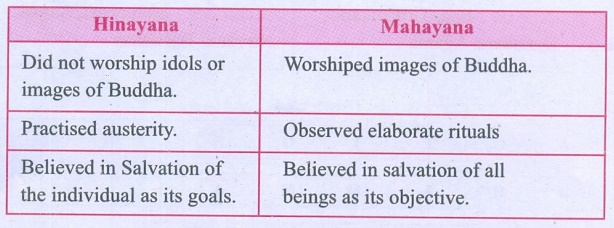
Hinayana
1. Did not worship idols or images of Buddha.
2. Practised
austerity.
3. Believed in
Salvation of the individual as its goals.
Mahayana
1. Worshiped images of
Buddha.
2. Observed elaborate
rituals
3. Believed in
salvation of all beings as its objective.
5. Jainism and Buddhism
flourished in Sangam period. Give any two evidences for each.
❖ In ancient Tamil literature, Jainism is referred to as Samanam.
❖ There is a Samanar Hill or Samanar Malai in Keelakuyilkudi village, 15 km
away from Madurai. The images of Tirthankaras created by Jain monks are found
in the hill.
❖ Manimekalai, one of the epics of the post-Sangam age is a Buddhist
literature.
❖ There is an elaborate description about Kanchipuram in classical epic
Manimegalai.
VIII HOTS:
1. Karma – a person’s action.
Name any 10 good actions (deeds).
1. Truthfulness
2. Obedience
3. Punctuality
4. Responsibility
5. Hospitality
6. Discipline
7. Morality
8. Sendee
9. Loyalty
10. Sympathy
IX Student Activity
1. Read any one story from Jatakas and write a
similar story on your own.
2. Make a tabular column in the
following headings.

3. Place the following words in the appropriate
column.
Words: Jina, Mahayana, Tirthankaras, Stupas Nirvana,
Digambara, Tripitakas, Agama

Jainism : Jina, Tirthankaras,
Diambara, Agama
Buddhism : Mahayana, Stupas, Nirvana, Tripitakas
4. Task cards activity:
Make informative cards for the
following religions. Hinduism, Christianity, Islam, Buddhism, Jainism
5. Make a Venn diagram to
indicate similarities and dis-similarities of Jainism and Buddhism.
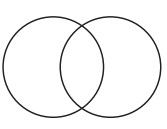
6. Solve the puzzle
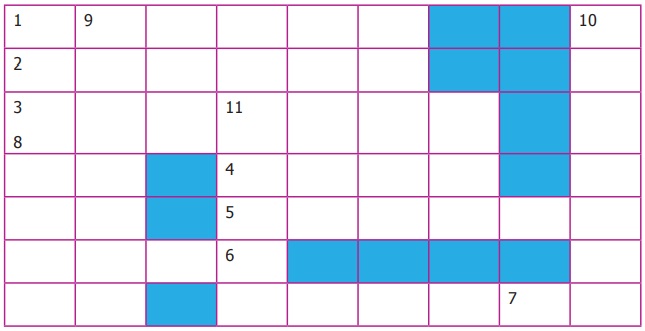
Left to right
1. One of the Tri Rathna: Right -
2. Buddha’s teachings are
referred as -
3. A great centre of education -
4. The place where Buddha
attained enlightment -
5. Not to injure any living being -
Right to left
6. Mother of Siddhartha -
7. The Quality of man’s life
depends on his deed -
Top to bottom
8. Lumbini is in -
9. Buddhist prayer hall -
10. A state of freedom from birth -
11. Jain scripture compiled by
Gautama Swami. -
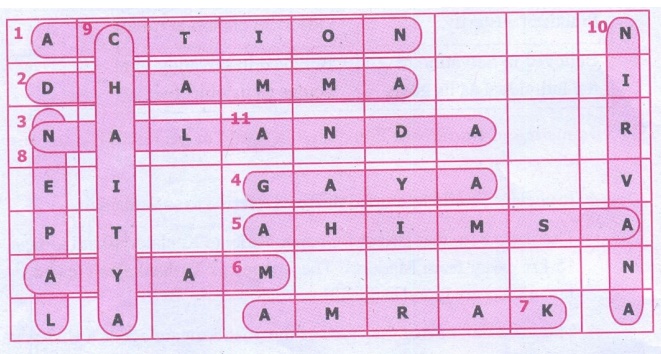
X. Life Skills
Create a story board for Jainism/Buddhism in a
chart
Model.
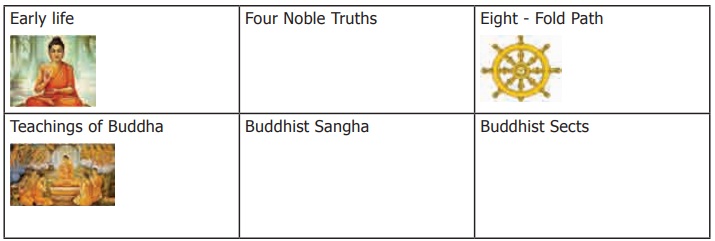
XII Answer Grid
The
Jain monks who wear white cloths are called
Ans :
Svetambaras
What
is the meaning of Buddha?
Ans : the Enlightened
Who
is the 24th Tirthankara of Jainism?
Ans : Mahavira
Who
delivered Dharmachakra Pravartana?
Ans : Buddha
How
many noble truths are there in Buddhism?
Ans : Four
Which
religion's teachings include four noble truths and eitht-fold path?
Ans : Budhism
Name
the earliest Buddhist literature which deals with the stories of various births
of Buddha?
Ans : Jatakas
Name
any four places where Jain monasteries were located in Tamil Nadu.
Ans : Puhar, Uraiyur
Madurai, Vanchi
Name
one of the twin classical Epics
Ans : Manimekalai
Related Topics